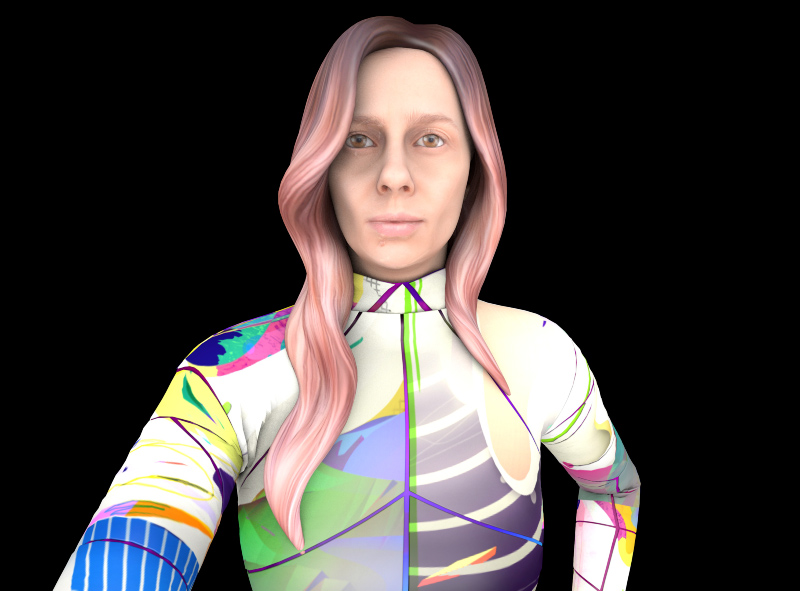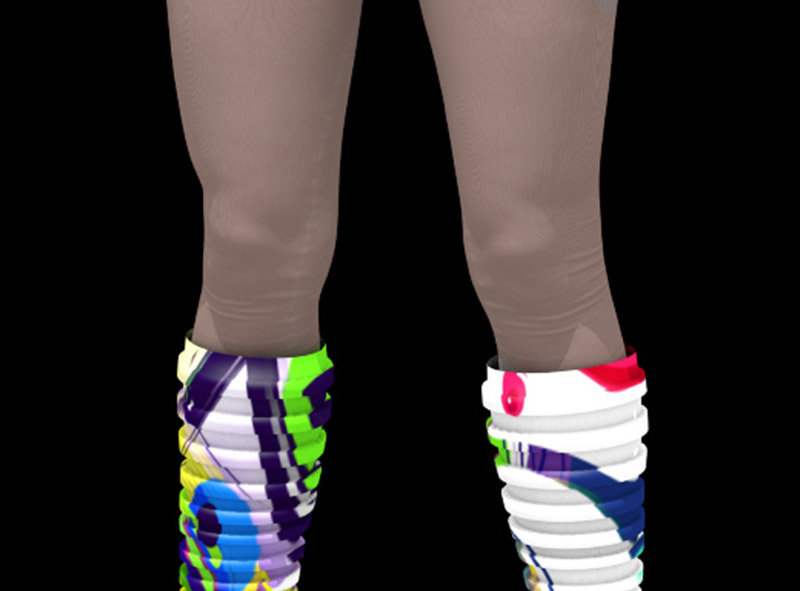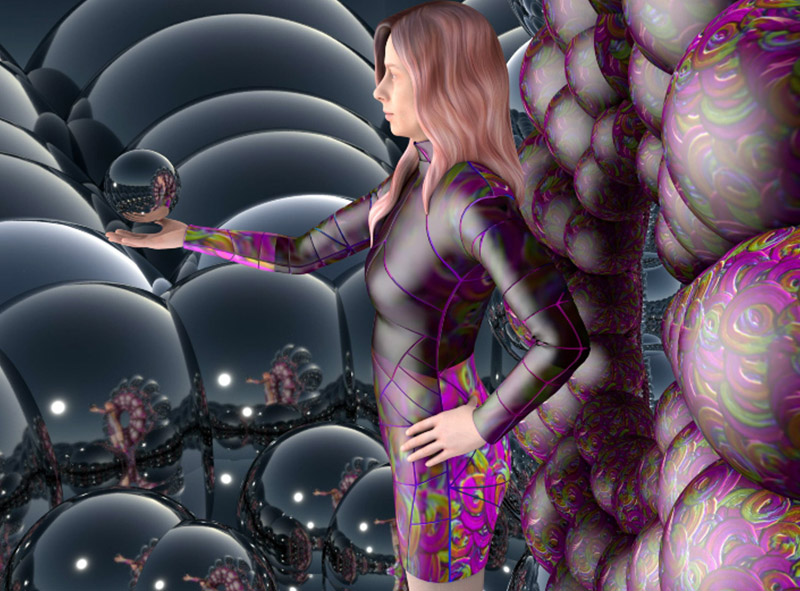AVATAR
I present to you my avatar Mageiah, created more than a year ago by Nauhyotzin (My friend and collaborator of many projects). It consists of a three-dimensional model of my body made with photogrammetry, a 360-degree photo scan. When I saw it for the first time I felt some terror, although I could identify it only as a digital file, I inevitably connected it to a lot of futuristic thoughts.
I love technology, I live on it and with it. I currently spend more time working in virtual reality than using my laptop. The pandemic stage led me not only to a psychological implosion, but also to a virtual implosion, so it was inevitable that all kinds of thoughts about the virtualizing process that we are now living in will hit me.
The experience of attending and collaborating in virtual events, such as the Burningman Virtual Festival 2020, coupled with the amazement of seeing my avatar in virtual reality on a real scale, surpassed me. That’s why I preferred to leave the avatar saved for a little while. However, the idea of using it to have a presence in virtual worlds still flirts with me. And by presence, I mean what Helen Papagiannis cited in her book “Augmented Human”:
“Presence is a term used in VR to describe the perception and sensation of really ‘being there’ in the computer-generated environment, as though it were a real place. It’s a measure of how well a virtual environment succeeds in immersing a user,” writes Helen Papagiannis. On the flip side, presence in AR refers to the perception of virtual content fusing with our own physical environment.
Media theorists Matthew Lombard and Theresa Ditton define presence as “the illusion of non-mediation” where “the medium can appear invisible or transparent and function as a large open window, with the average user and the content medium (objects and entities) sharing the same. “
Apart from the idea of having a presence in virtual worlds, I also reflected on artificial intelligence, specifically on the possible consciousness that emerges from an avatar. Since a series of analogies of human and digital life have haunted me ever since. And although the idea of the avatar is not new, since in India there are those who worship Vishnu for many centuries, considered one of their most important gods. God who according to his own stories has had many avatars, of which the best known are Krishna and Buddha. So between theology, science fiction and technology, the idea of the avatar emerges as a human utopia of immortality, since throughout our history we have sought immortality in various ways: from mummification and cryogenics to artificial intelligence, which seeks to transfer our consciousness to the digital world.
I recently listen to a lecture by Carlos Blanco, where he says: An avatar that is not you, but is like you, in practical terms, what is it? Interesting to ponder.
On the other hand, Gartner recently published a text where he talks about conscious computing, and mentions that it occurs in 4 phases: “Sync me, see me, know me and be me.” The interesting thing here is to ask ourselves, in what phase are we now?
The idea of fiction, with respect to artificial intelligence, where an entity created by us can first be conscious, become self-conscious, that is, know that it is created by someone else. It is something that has blown our minds for a long time.
I do not know if a machine or any digital entity has the need to know by whom it was created, or if it only arises in us humans. I mean knowing where we come from, be it divine creation, the big bang, an origin based on Darwin’s evolutionary theory or any other possibility.
From all this I have more questions than answers, since I am just an observer who has always been struck by alternate realities. In my case, since I started designing virtual worlds, I have asked myself, why do we want to create worlds beyond this world?
Could it be that it is pleasing to our senses? and that is why chemically it produces a great desire to inhabit them? or being more ambitious to design them? And when we inhabit them, what exactly do we experience?
That is, when I am physically, for example, in my living room and I put on the virtual reality goggles, from there I interact and I move in the virtual space, but where am I really? What kind of juxtaposed place is that?
It is impossible for me to ignore one of my favorite books, Foucault’s Topologies (1966), which talks about the different types of spaces that exists. It is striking how he makes a distinction between what is a utopia and a heterotopia:
Utopia: utopia from the Greek ou-no and topo-place.
Utopias do not have a real and tangible space; they inhabit the space of the imagination or desire in fiction.
Heterotopia: From the Greek hetero-other and topos-place.
The spaces are absolutely other; they are actually made and localized utopias.
The rule of heterotopia is to juxtapose in a physical place several spaces that would normally be, or should be, incompatible: the theater, the garden, a rug.
I would love to be able to ask Foucault about a virtual environment, is it a utopia or a heterotopia? Or is it both?
In context, the extended realities (virtual reality, augmented reality, mixed realities) from a technological stance, can they be located as the alternate realities posed by philosophy?
And to go deeper into the possibility that this can offer us, I quote again an excerpt from the book “Augmented Human” by Helen Papagiannis.
“I see augmented reality as a form of fantasy, creating a virtual story that can be visual, audible, tangible, olfactory, and even one that can be savored. The human capacity to make believe is an extraordinary power. “If you want to imagine how something looks, or how it was ever seen, you can resort to images that recreate everything from technology. That should be your choice, just like you can choose between reading a book or watching a movie. When you watch a movie or experience something that is technologically rendered or enhanced, it doesn’t mean that you are no longer using your imagination; you continue to apply it, further expanding what you imagine.
On top of this I like to think about the evolutionary perspective of technology, since it invites you to question yourself, what is there after the horizon? And if you decide to be an active user, it invites you to propose. This is where many questions can arise. What are we creating? What minds write about future fiction? Who has the possibility to develop it? At the service of what or who is it addressing? Who is supervising everything and under what kind of ethics?
It is important to be aware of how we relate to technology in digital media and to be attentive as active users, without going into detail I share:
Starting with an article published in 2013, Zuboff popularized the concept of surveillance capitalism, “surveillance capitalism,” a new economic order that uses human experience as raw material to generate behavioral data. Some data is used to improve products or services, but the rest is considered “a behavioral surplus owned by the capitalist surveillance companies themselves.” These products are traded in what Shoshana Zu-boff calls “behavioral futures markets.” “When the product is free, the product is you,” says the cliché.
New technologies advance faster than the responses to their own taboos. That is why the importance of humanizing technology, since in its best version it could provide us with other ways of experimenting and connecting. Formats impossible from the reality we inhabit.
I am excited by the idea that one day technology can help us make a quantum leap, so my position on technological possibilities is positive. At least from my humble trench and personal work, I try to direct it so that it adds up. That’s why from my perspective I conclude with this thought:
“Technology in its most sublime state is magic and magic in its most sublime state transforms.
PS










